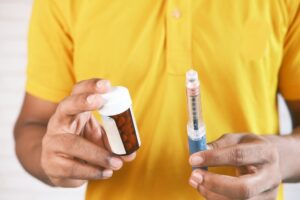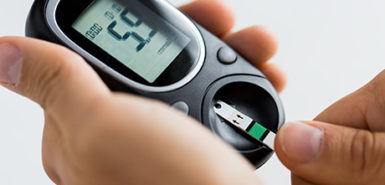
The high cost of insulin is a leading concern for those with diabetes, skyrocketing in the last 20 years. And while ongoing changes reduce the price–at least for some patients–newer medications add to the confusion.
The good news is that help is on the way, including new laws that cap costs for seniors and generic insulin that may be available as soon as next year.
The bad news? It takes real work to unravel the cost complexity and get the best deal possible on these life-saving medications.
“Sometimes it feels like untangling the biggest ball of yarn ever,” said Stephanie Field, director of pharmacy business services at Corewell Health.
That’s why Corewell now has a Medication Care Coordination Team to help patients untangle insurance riddles, doing their best to simplify coverage for complicated medication regimens.
“We make sure that this is the most cost-effective approach for the patient and that they’re getting the right medication that’s covered by their insurance,” she said.
Sometimes, that isn’t possible.
“In those cases, we help with medication assistance, which might be a co-pay card or a grant. There are opportunities for us to help get coverage,” she said.
Some pharmaceutical companies offer relief.
And companies like GoodRx are also helping patients find their way to money-saving coupons and drug rebates.
Field says Corewell Health works with patients to help them find out as much as possible before they get stunned by sticker shock at the pharmacy window.
And it’s working. Field said the average time from prescription to pharmacy pick-up has gone from seven and a half days to three days.
“And we’ve seen a significant reduction in patient’s out-of-pocket cost,” she said.
Understanding the cost complexity
It helps to understand how diabetes costs have gotten so out of control. Insulin was discovered more than 100 years ago–and for the 1.9 million people in the U.S. with type 1 diabetes, it’s essential.
Insulin is a hormone that occurs naturally in the body, secreted by the pancreas. People with type 1 diabetes don’t produce it at all.
People with type 2 diabetes create their own insulin, but their body doesn’t use it correctly. They can typically manage this with lifestyle changes and oral medications. But in some cases, they also need insulin injections.
More than 37 million Americans have diabetes, according to the American Diabetes Association, about 11% of the population–and it’s growing at epidemic levels.
An estimated 8 million people in the U.S. rely on insulin.
As that number increases, it puts more pressure on insulin supply, a market controlled by three pharmaceutical giants.
“These three manufacturers are making insulin for the entire world,” said Gregory Deines, DO, a Corewell Health Spectrum Medical Group internal medicine physician. “It takes a significant investment to build manufacturing facilities that can safely make the drug molecule.”
Semglee, a biosimilar form of insulin made by a fourth company, recently hit the market. (Biosimilar drugs are defined as biological formulas that are so similar to the drugs they mimic that there is no clinical difference. On the other hand, generic drugs are identical to the brand-name drugs they copy.)
While that has improved affordability for some patients, many advocates are disappointed with the limited impact.
Field shares patients’ frustration. While the median out-of-pocket price paid by patients within the Corewell Health system for their insulin is $20.70, some patients pay $165, depending on their insurance.
“It’s concerning,” she said.
And people with different insurance and education levels have varying degrees of healthcare literacy.
Even for experts like her, navigating that maze is challenging.
“I’ve done this for 13 years and still struggle with my parents, getting them to the right choices,” she said.
Some patients face bills as high as $2,100 a month.
“No middle-income person could afford that,” she said. “You’d have to be a millionaire. At some point, you’d probably just give up.”
Sadly, many people are forced to make unsafe choices.
A recent study found that 17% of insulin users either skipped insulin doses, took less insulin than needed, or delayed filling prescriptions due to financial constraints.
And among Black Americans, rationing was even more common, affecting 23%, compared to 16% of white and Hispanic Americans.
New drugs add to the confusion
Insulin isn’t the only medication for diabetes that is prohibitively expensive. Newer drugs for type 2 diabetes, such as Ozempic, Trulicity and Mounjaro, are highly effective in obesity-related diabetes. But they can cost patients as much as $1,000 per month.
And publicity about those costs, Field said, adds to the perception that all diabetes drugs are that expensive.
“The nuances are lost on many people, and it becomes kind of a muddled story,” she said.
Groundbreaking legislation recently capped the cost of insulin at $35 for Medicare, which covers America’s senior citizens.
But that life-saving measure comes at a price. A recent study from the Congressional Budget Office shows that it also raises the cost to the government and drives up the cost of insurance premiums.
Taxpayers and consumers also shoulder those costs.
Michigan is working to lower costs by manufacturing insulin in the state. It is one of several states calling for investigations of Eli Lilly & Co., Sanofi and Novo Nordisk for their pricing policies.
The same vial of insulin that costs $98 in the U.S. is available for $12 in Canada, $8 in the U.K., and $7 in the U.S., according to an analysis from Rand.
On average, insulin prices in the U.S. are eight times higher than in 32 high-income nations.
For the most part, pharmaceutical companies, however, defend the pricing of their products.
“It’s long been the pharmaceutical industry’s philosophy that they have a right to do this since it costs billions of dollars to create one new drug–and since so many new drugs fail,” said Dr. Deines.
Managing the high cost of medications
Relief is coming–eventually. Eli Lilly recently slashed the price of its insulin, capping it at $35 for everyone. Civica, a non-profit organization, has plans to introduce three biosimilar insulins starting early in 2024.
Until then, he said the most important step “is to make sure you understand your insurance benefits.”
It’s vital to know which medications are covered and which aren’t and how to get the lowest possible co-pay.
And that entails checking in with your insurer annually since plans often change.
Unfortunately, he said, many people could be paying less and don’t know it. And while plans are required to notify patients of changes, “often, the letter came three months ago, and the impact isn’t clear until it’s time to pay for their medication at the pharmacy.”
It’s also important to ask your provider how a new prescription fits into coverage.
 /a>
/a>
 /a>
/a>
 /a>
/a>